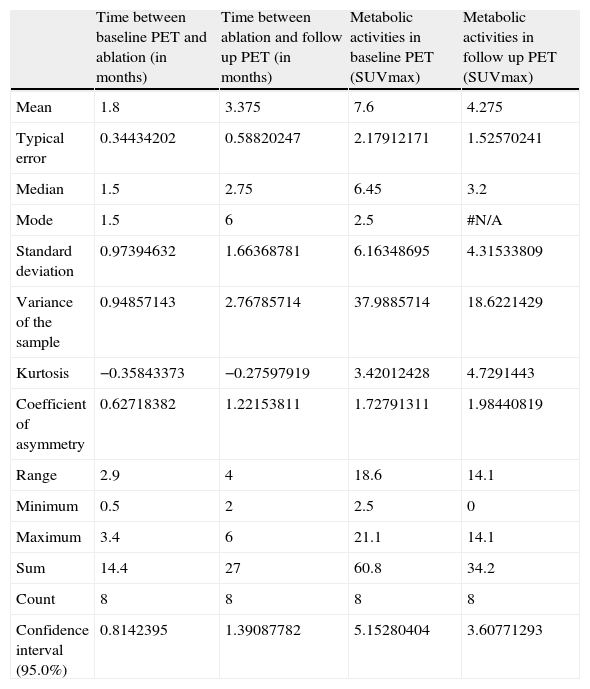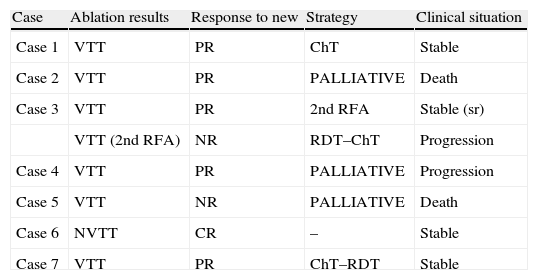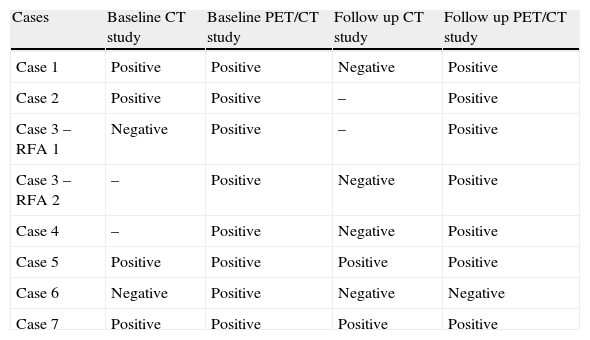Although they have proven effectiveness, radiofrequency and microwave ablation techniques have a high rate of partial responses. Diagnostic studies that anticipate the changes in morphology are essential for earlier detection of residual viable tumor tissue or local recurrences to identify patients who will benefit from a new treatment. Our study has determined the diagnostic yield of PET/CT studies at baseline and follow-up and adequate time between them and the ablation intervention. Seven patients with single tumor lesion with a total of 8 ablations were included. CT and PET/CT studies were performed at baseline and follow-up after ablation. Average times between PET studies at baseline and follow-up and the ablative therapy were 1.8 and 3.4 months, respectively. Mean scores in metabolic activities of the PET at baseline and follow-up were 7.6 and 4.3g/ml of SUVmax, respectively. The Dual Time Point technique helped to identify viable tissue after ablation in 3 cases. Follow-up PET/CT studies have conditioned the various treatment strategies adopted by clinical oncologists. The high yield of the PET/CT study including the Dual Time Point technique may be considered as a study replacement of initial and follow-up contrast-enhanced CT before and after treatment with RFA and AMO, this achieving considerable reduction in the exposure to high radiation levels. We propose conducting the first PET/CT follow-up study at 3 months of the RFA and AMO.
Aunque con efectividad probada, las técnicas de ablación por radiofrecuencia y microondas presentan un elevado índice de respuestas parciales. Es imprescindible contar con estudios diagnósticos que se anticipen a los cambios morfológicos para una detección más temprana del tejido tumoral residual viable o de recurrencias locales para determinar los pacientes que serán beneficiados de un nuevo tratamiento. Determinamos mediante nuestro estudio la rentabilidad diagnóstica de los estudios de PET/TC basal y de seguimiento y el tiempo adecuado entre estos y la intervención por ablación. Incluimos 7 pacientes con lesión tumoral única con un total de 8 ablaciones. Hemos realizado estudios CT y PET/TC basales y de seguimiento tras ablación. Los tiempos medios entre estudios PET basales y de seguimiento y la terapia ablativa fueron 1,8 y 3,4 meses respectivamente. Las cuentas medias en actividades metabólicas de los PET basales y de seguimiento han sido de 7,6 y 4,3g/ml de SUVmax respectivamente. La técnica de Dual Time Point ayudó en 3 casos a identificar tejido viable tras ablación. Los estudios de seguimiento PET/TC han condicionado las diversas estrategias terapéuticas adoptadas por los oncólogos clínicos. El alto rendimiento del estudio PET/TC incluyendo la técnica de Dual Time Point puede plantearse como estudio de sustitución de los CT con CIV basales y de seguimiento previo y posterior al tratamiento con ARF o AMO logrando reducir de manera considerable la exposición a altas cifras de radiación. Proponemos realizar el primer estudio PET/TC de seguimiento a los 3 meses de realizada la ARF o AMO.
Article
If you experience access problems, you can contact the SEMNIM Technical Secretariat by email at secretaria.tecnica@semnim.es or by phone at +34 619 594 780.

Revista Española de Medicina Nuclear e Imagen Molecular (English Edition)












